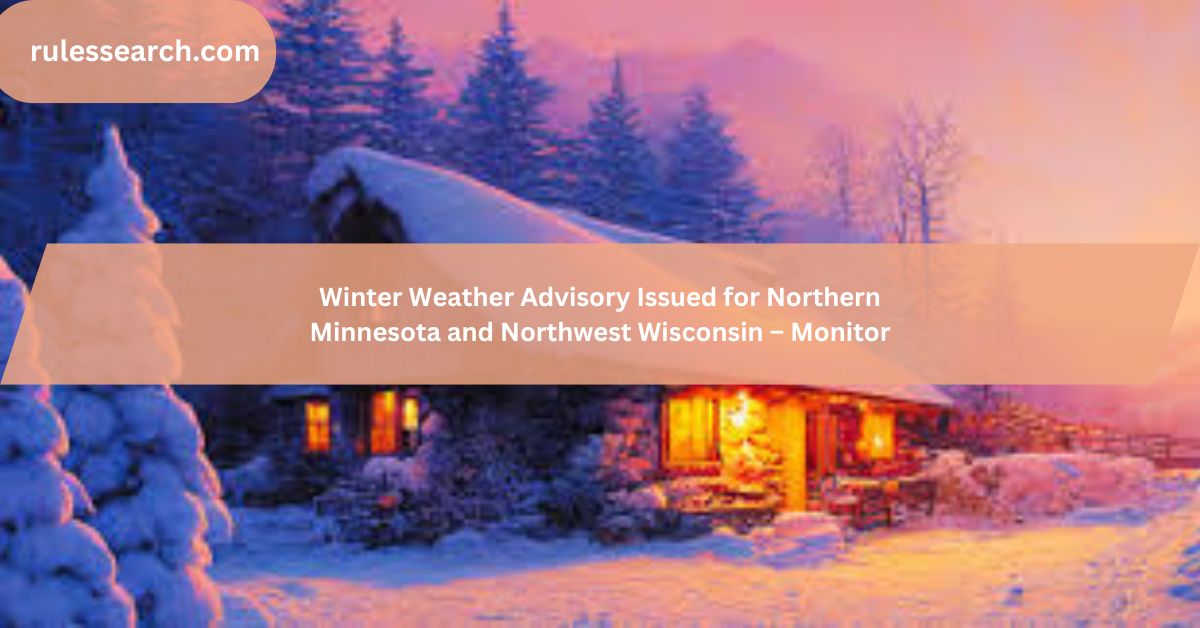Weather Updates
The National Weather Service has issued a Winter Weather Advisory Issued for Northern Minnesota and Northwest Wisconsin advisory for northern Minnesota and northwest Wisconsin as a powerful storm system is set to bring heavy snowfall, strong winds, and blizzard conditions to the region. AccuWeather forecasters predict over a foot of snow in some areas, with the storm’s impact expected to expand eastward later in the week, potentially affecting portions of the Upper Midwest and the interior Northeast. This article provides a comprehensive analysis of the upcoming winter weather, its potential impacts, and essential preparations for residents in the affected areas.
The Arrival of the Storm System
Origins and Path of the Storm
The source of this significant WinterWeather Advisory Issued for Northern Minnesota and Northwest Wisconsin event began over the past weekend, as a storm system moved onshore in the Pacific states. Coastal California experienced heavy rain, while the inland regions of the Intermountain West were blanketed with substantial snowfall. Following a typical storm track, the system shifted eastward into the Plains on Tuesday, bringing with it the potential for severe winter weather.
Forecast for Winter Weather Advisory Issued for Northern Minnesota and Northwest Wisconsin
AccuWeather forecasters have indicated that the northern Plains will bear the brunt of this storm through Wednesday. Northern Minnesota and northwest Wisconsin are expected to see significant snowfall, strong winds, and blizzard conditions. These conditions are anticipated to create hazardous travel situations and potential power outages.
Impacts of the Storm
Snow Accumulation and Blizzard Conditions
The storm is predicted to deposit over a foot of snow in some areas, leading to difficult travel conditions. The combination of heavy snowfall and strong winds will result in blizzard conditions, characterized by reduced visibility and drifting snow. This will make driving treacherous and could lead to road closures and delays.
Wind Chill and Temperature Drops
In addition to heavy snowfall, the storm will bring a sharp drop in temperatures. Wind chills could plummet to dangerously low levels, posing a risk of frostbite and hypothermia for those exposed to the cold for extended periods. Residents are advised to dress in layers and limit time spent outdoors.
Potential for Power Outages
The combination of heavy snow and strong winds increases the risk of power outages. Snow-laden trees and branches can fall onto power lines, causing disruptions in electrical service. Residents should prepare for potential outages by having emergency supplies on hand, such as flashlights, batteries, and non-perishable food.
Preparations and Safety Tips
Winterizing Homes and Vehicles
Residents in the affected areas should take steps to winterize their homes and vehicles. This includes ensuring that homes are properly insulated, pipes are protected from freezing, and heating systems are in good working order. Vehicles should be equipped with winter tires, and emergency kits should be prepared, including blankets, food, water, and a first-aid kit.
Staying Informed and Connected
Staying informed about the latest weather updates is crucial. Residents should monitor local news and weather channels for updates on the storm’s progress and any advisories or warnings issued by authorities. Having a reliable means of communication, such as a fully charged cell phone, is also essential.
Emergency Preparedness
Being prepared for emergencies is vital during severe Winter Weather Advisory Issued for Northern Minnesota and Northwest Wisconsin events. Residents should have an emergency plan in place, including a designated meeting spot and a list of emergency contacts. It’s also important to have a supply of essential medications and to ensure that pets are taken care of.
Long-term Effects and Considerations
Impact on Infrastructure
The heavy snowfall and blizzard conditions will likely have a significant impact on infrastructure. Roads, bridges, and public transportation systems may be affected, leading to delays and disruptions. Authorities will need to deploy resources for snow removal and repair efforts.
Economic Implications
Severe Winter Weather Advisory Issued for Northern Minnesota and Northwest Wisconsin can have economic implications, particularly for industries reliant on transportation and logistics. Delays and disruptions caused by the storm could affect supply chains, leading to shortages and increased costs for goods and services.
Community Resilience
Communities in Winter Weather Advisory Issued for Northern Minnesota and Northwest Wisconsin are accustomed to harsh winter conditions, but the severity of this storm will test their resilience. It’s essential for residents to support one another, check on vulnerable neighbors, and work together to navigate the challenges posed by the storm.
The Role of AI in Weather Forecasting
Advancements in Forecasting Technology
The increased role of artificial intelligence (AI) in weather forecasting has led to significant advancements in the accuracy and timeliness of predictions. AI algorithms analyze vast amounts of data from various sources, providing more precise and reliable forecasts.
Benefits for Public Safety
Accurate weather forecasts are crucial for public safety, allowing residents to prepare adequately for severe weather events. AI-enhanced forecasting enables authorities to issue timely warnings and advisories, helping to mitigate the impacts of storms like the one affecting northern Minnesota and northwest Wisconsin.
Future Developments
As AI technology continues to evolve, its application in weather forecasting will likely become even more sophisticated. Future developments could include real-time updates and personalized weather alerts, further enhancing the ability of individuals and communities to respond to severe Winter Weather Advisory Issued for Northern Minnesota and Northwest Wisconsin.
Conclusion:
The winter weather advisory issued for northern Minnesota and northwest Wisconsin highlights the need for preparedness and resilience in the face of severe winter storms. With over a foot of snow expected, along with strong winds and blizzard conditions, residents must take proactive measures to ensure their safety and well-being. By staying informed, winterizing homes and vehicles, and having an emergency plan in place, communities can navigate the challenges posed by this significant Winter Weather Advisory Issued for Northern Minnesota and Northwest Wisconsin event.
FAQ’s:
1. What is the expected snowfall for Winter Weather Advisory Issued for Northern Minnesota and Northwest Wisconsin?
Forecasters predict over a foot of snow in some areas of northern Minnesota and northwest Wisconsin, creating significant accumulations that will impact travel and daily activities.
2. How can residents prepare for potential power outages?
Residents should prepare by having emergency supplies such as flashlights, batteries, non-perishable food, and backup heating options to stay safe and comfortable during outages.
3. What are the dangers of blizzard conditions?
Blizzard conditions cause reduced visibility and drifting snow, making travel hazardous and potentially leading to road closures and delays, increasing the risk of accidents.
4. How can vehicles be prepared for Winter Weather Advisory Issued for Northern Minnesota and Northwest Wisconsin?
Equip vehicles with winter tires and prepare emergency kits including blankets, food, water, and a first-aid kit to ensure safety if stranded or delayed.
5. Why is it important to stay informed during severe Winter Weather Advisory Issued for Northern Minnesota and Northwest Wisconsin events?
Staying informed allows residents to receive timely updates on the storm’s progress, advisories, and warnings, enabling them to make safe decisions and preparations.
6. What should be included in an emergency plan?
An emergency plan should include a designated meeting spot, a list of emergency contacts, essential medications, and provisions for pets to ensure everyone’s safety and well-being.
7. How does AI improve weather forecasting?
AI analyzes vast amounts of data from various sources, providing more precise and reliable weather forecasts, which enhance preparedness and response efforts.
8. What are the economic implications of severe Winter Weather Advisory Issued for Northern Minnesota and Northwest Wisconsin?
Severe winter weather can disrupt transportation and logistics, leading to supply chain issues, increased costs for goods and services, and economic challenges for businesses.
9. How can communities support one another during severe Winter Weather Advisory Issued for Northern Minnesota and Northwest Wisconsin?
Communities can support one another by checking on vulnerable neighbors, sharing resources, and working together to navigate challenges, ensuring collective safety and resilience.
10. What long-term effects can severe Winter Weather Advisory Issued for Northern Minnesota and Northwest Wisconsin have on infrastructure?
Heavy snowfall and blizzard conditions can impact roads, bridges, and public transportation systems, leading to delays and the need for significant repair and maintenance efforts.


